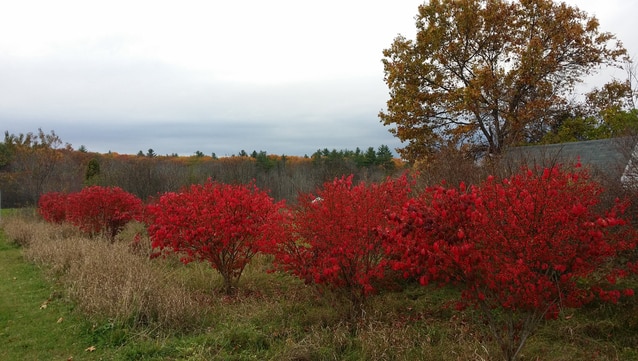Make a dramatic statement in your fall garden by planting burning bush (Euonymus alatus). This easy-to-grow plant’s green-blue foliage transforms into a brilliant red each fall for several weeks. So bright is the foliage color that from a distance the plant appears to be on fire.
The burning bush is a fast-growing, deciduous shrub that reaches 8 to 10 feet tall and 6 to 8 feet wide when mature. The plant can be used for a variety of landscaping purposes. Plant burning bush as a showy mass in a garden bed, along a driveway or walkway, or use it to create a decorative screen. Burning bush also grows well in containers.
To have luck growing burning bush in your garden, keep the following cultivation tips in mind.
Plant in full-sun to part shade. Burning bush will thrive in most areas of the yard, except for full shade. Provide a minimum of six hours of sunlight a day.
Provide good drainage. Euonymus alatus prefers well-draining soil that is moist. Enrich the soil to hold moisture by amending with homemade or bagged compost. Also keep the area moist by mulching with a 2- to 3-inch layer of ground bark.
Water regularly. Burning bush requires consistent moisture to do well. Water when the top 1 to 2 inches of soil has dried out during the growing season. Keep in mind that containerized plants dry out more quickly. During the warmest days of the year, you may have to water potted burning bush daily or every other day.
Grow container burning bush in a rich, well-draining potting soil in a glazed ceramic, plastic or wooden container. Increase the potting soil’s fertility by adding one part worm compost to the mix at planting.
Shape as desired. Keep burning bush under control and growing in the manner you desire by pruning and thinning the plant when young. At this point you can set growth patterns. If you will be keeping it in a pot on the patio, prune off about 1/3 of the foliage in the late winter before the plant leafs out.
Fertilize occasionally. Burning bush isn’t a heavy feeder, but does best with some fertilizer. Apply a well-balanced, organic fertilizer once in the late winter, spring and summer.
Julie Bawden-Davis is a garden writer and master gardener, who since 1985 has written for publications such as Organic Gardening, Wildflower, Better Homes and Gardens and The Los Angeles Times. She is the author of seven books, including Reader’s Digest Flower Gardening, Fairy Gardening, The Strawberry Story, and Indoor Gardening the Organic Way, and is the founder of HealthyHouseplants.com

